Theories, Principles and Models in Education and Training - DET Report
VerifiedAdded on 2023/06/18
|18
|5960
|320
Report
AI Summary
This report provides a comprehensive analysis of various theories, principles, and models in education and training, particularly in the context of special needs education. It explores learning theories such as behaviorism, constructivism, and social learning theory, and their application in teaching and assessment. The report also examines models of learning preferences, communication theories, and assessment models, emphasizing their importance in inclusive teaching and curriculum development. Furthermore, it delves into theories and models of reflection and evaluation, highlighting their role in improving teaching practices and meeting the specific needs of children with disabilities. The report concludes by emphasizing the significance of these theories and models in creating effective and inclusive educational environments.
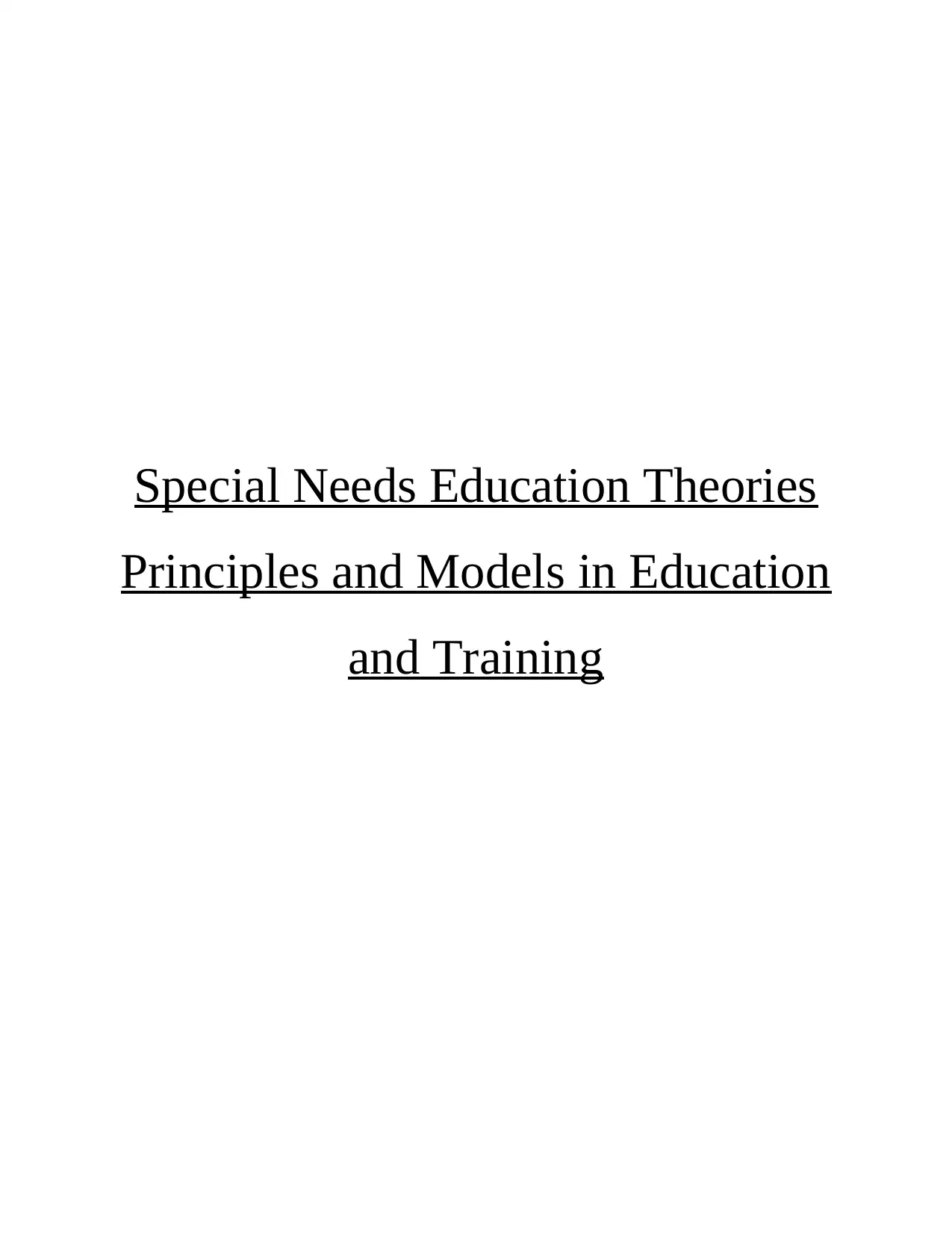
Special Needs Education Theories
Principles and Models in Education
and Training
Principles and Models in Education
and Training
Paraphrase This Document
Need a fresh take? Get an instant paraphrase of this document with our AI Paraphraser
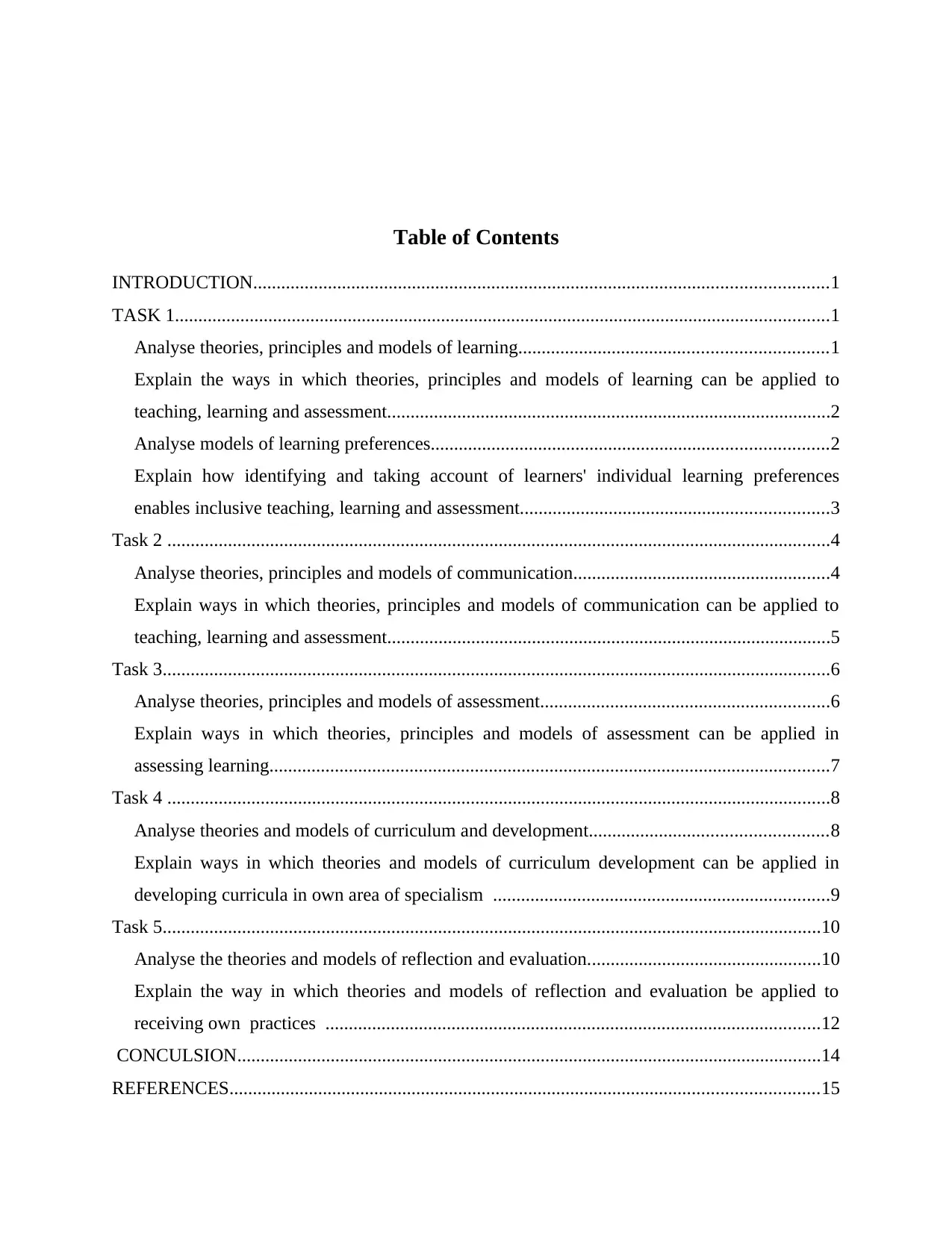
Table of Contents
INTRODUCTION...........................................................................................................................1
TASK 1............................................................................................................................................1
Analyse theories, principles and models of learning..................................................................1
Explain the ways in which theories, principles and models of learning can be applied to
teaching, learning and assessment...............................................................................................2
Analyse models of learning preferences.....................................................................................2
Explain how identifying and taking account of learners' individual learning preferences
enables inclusive teaching, learning and assessment..................................................................3
Task 2 ..............................................................................................................................................4
Analyse theories, principles and models of communication.......................................................4
Explain ways in which theories, principles and models of communication can be applied to
teaching, learning and assessment...............................................................................................5
Task 3...............................................................................................................................................6
Analyse theories, principles and models of assessment..............................................................6
Explain ways in which theories, principles and models of assessment can be applied in
assessing learning........................................................................................................................7
Task 4 ..............................................................................................................................................8
Analyse theories and models of curriculum and development...................................................8
Explain ways in which theories and models of curriculum development can be applied in
developing curricula in own area of specialism ........................................................................9
Task 5.............................................................................................................................................10
Analyse the theories and models of reflection and evaluation..................................................10
Explain the way in which theories and models of reflection and evaluation be applied to
receiving own practices ..........................................................................................................12
CONCULSION.............................................................................................................................14
REFERENCES..............................................................................................................................15
INTRODUCTION...........................................................................................................................1
TASK 1............................................................................................................................................1
Analyse theories, principles and models of learning..................................................................1
Explain the ways in which theories, principles and models of learning can be applied to
teaching, learning and assessment...............................................................................................2
Analyse models of learning preferences.....................................................................................2
Explain how identifying and taking account of learners' individual learning preferences
enables inclusive teaching, learning and assessment..................................................................3
Task 2 ..............................................................................................................................................4
Analyse theories, principles and models of communication.......................................................4
Explain ways in which theories, principles and models of communication can be applied to
teaching, learning and assessment...............................................................................................5
Task 3...............................................................................................................................................6
Analyse theories, principles and models of assessment..............................................................6
Explain ways in which theories, principles and models of assessment can be applied in
assessing learning........................................................................................................................7
Task 4 ..............................................................................................................................................8
Analyse theories and models of curriculum and development...................................................8
Explain ways in which theories and models of curriculum development can be applied in
developing curricula in own area of specialism ........................................................................9
Task 5.............................................................................................................................................10
Analyse the theories and models of reflection and evaluation..................................................10
Explain the way in which theories and models of reflection and evaluation be applied to
receiving own practices ..........................................................................................................12
CONCULSION.............................................................................................................................14
REFERENCES..............................................................................................................................15
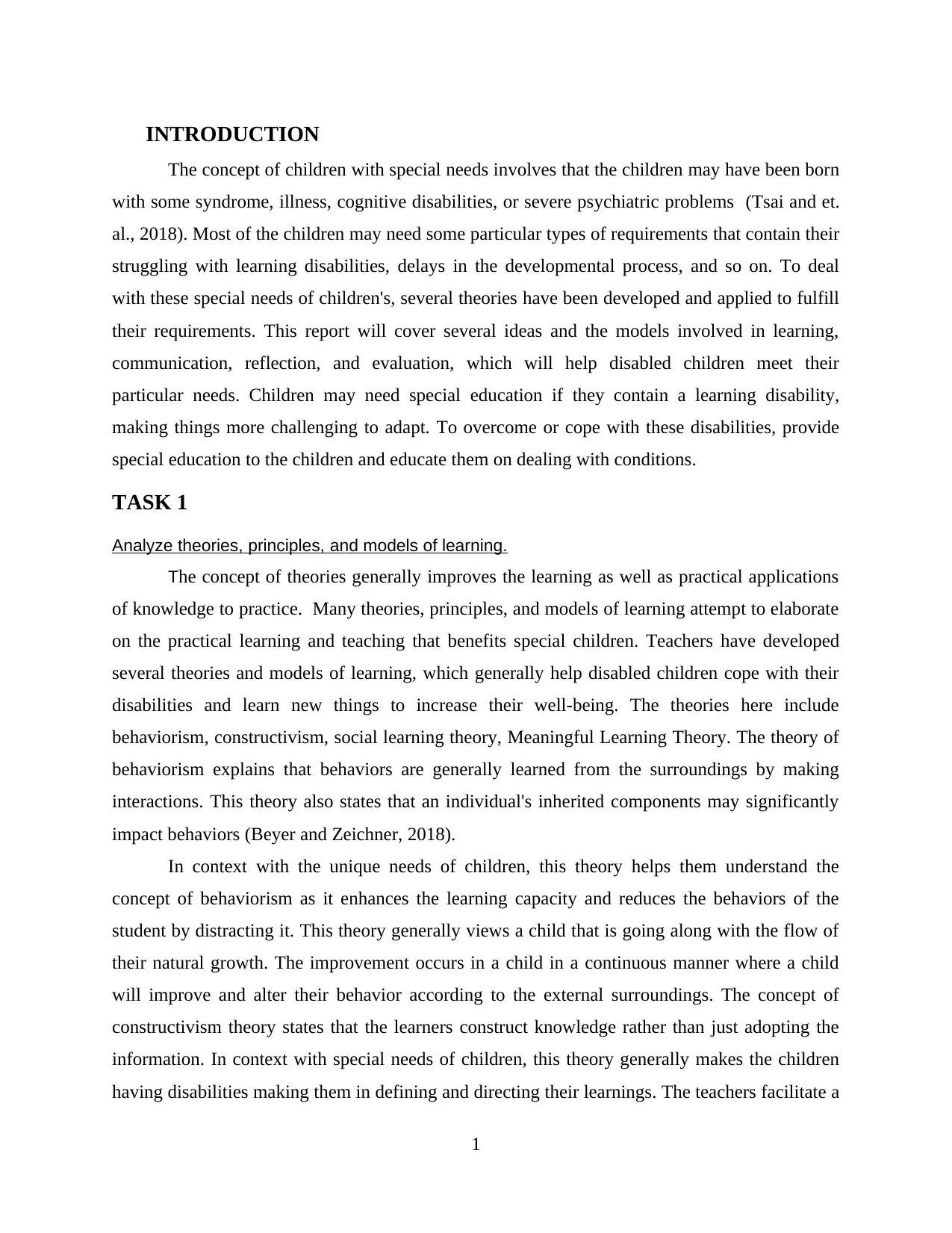
INTRODUCTION
The concept of children with special needs involves that the children may have been born
with some syndrome, illness, cognitive disabilities, or severe psychiatric problems (Tsai and et.
al., 2018). Most of the children may need some particular types of requirements that contain their
struggling with learning disabilities, delays in the developmental process, and so on. To deal
with these special needs of children's, several theories have been developed and applied to fulfill
their requirements. This report will cover several ideas and the models involved in learning,
communication, reflection, and evaluation, which will help disabled children meet their
particular needs. Children may need special education if they contain a learning disability,
making things more challenging to adapt. To overcome or cope with these disabilities, provide
special education to the children and educate them on dealing with conditions.
TASK 1
Analyze theories, principles, and models of learning.
The concept of theories generally improves the learning as well as practical applications
of knowledge to practice. Many theories, principles, and models of learning attempt to elaborate
on the practical learning and teaching that benefits special children. Teachers have developed
several theories and models of learning, which generally help disabled children cope with their
disabilities and learn new things to increase their well-being. The theories here include
behaviorism, constructivism, social learning theory, Meaningful Learning Theory. The theory of
behaviorism explains that behaviors are generally learned from the surroundings by making
interactions. This theory also states that an individual's inherited components may significantly
impact behaviors (Beyer and Zeichner, 2018).
In context with the unique needs of children, this theory helps them understand the
concept of behaviorism as it enhances the learning capacity and reduces the behaviors of the
student by distracting it. This theory generally views a child that is going along with the flow of
their natural growth. The improvement occurs in a child in a continuous manner where a child
will improve and alter their behavior according to the external surroundings. The concept of
constructivism theory states that the learners construct knowledge rather than just adopting the
information. In context with special needs of children, this theory generally makes the children
having disabilities making them in defining and directing their learnings. The teachers facilitate a
1
The concept of children with special needs involves that the children may have been born
with some syndrome, illness, cognitive disabilities, or severe psychiatric problems (Tsai and et.
al., 2018). Most of the children may need some particular types of requirements that contain their
struggling with learning disabilities, delays in the developmental process, and so on. To deal
with these special needs of children's, several theories have been developed and applied to fulfill
their requirements. This report will cover several ideas and the models involved in learning,
communication, reflection, and evaluation, which will help disabled children meet their
particular needs. Children may need special education if they contain a learning disability,
making things more challenging to adapt. To overcome or cope with these disabilities, provide
special education to the children and educate them on dealing with conditions.
TASK 1
Analyze theories, principles, and models of learning.
The concept of theories generally improves the learning as well as practical applications
of knowledge to practice. Many theories, principles, and models of learning attempt to elaborate
on the practical learning and teaching that benefits special children. Teachers have developed
several theories and models of learning, which generally help disabled children cope with their
disabilities and learn new things to increase their well-being. The theories here include
behaviorism, constructivism, social learning theory, Meaningful Learning Theory. The theory of
behaviorism explains that behaviors are generally learned from the surroundings by making
interactions. This theory also states that an individual's inherited components may significantly
impact behaviors (Beyer and Zeichner, 2018).
In context with the unique needs of children, this theory helps them understand the
concept of behaviorism as it enhances the learning capacity and reduces the behaviors of the
student by distracting it. This theory generally views a child that is going along with the flow of
their natural growth. The improvement occurs in a child in a continuous manner where a child
will improve and alter their behavior according to the external surroundings. The concept of
constructivism theory states that the learners construct knowledge rather than just adopting the
information. In context with special needs of children, this theory generally makes the children
having disabilities making them in defining and directing their learnings. The teachers facilitate a
1
⊘ This is a preview!⊘
Do you want full access?
Subscribe today to unlock all pages.

Trusted by 1+ million students worldwide
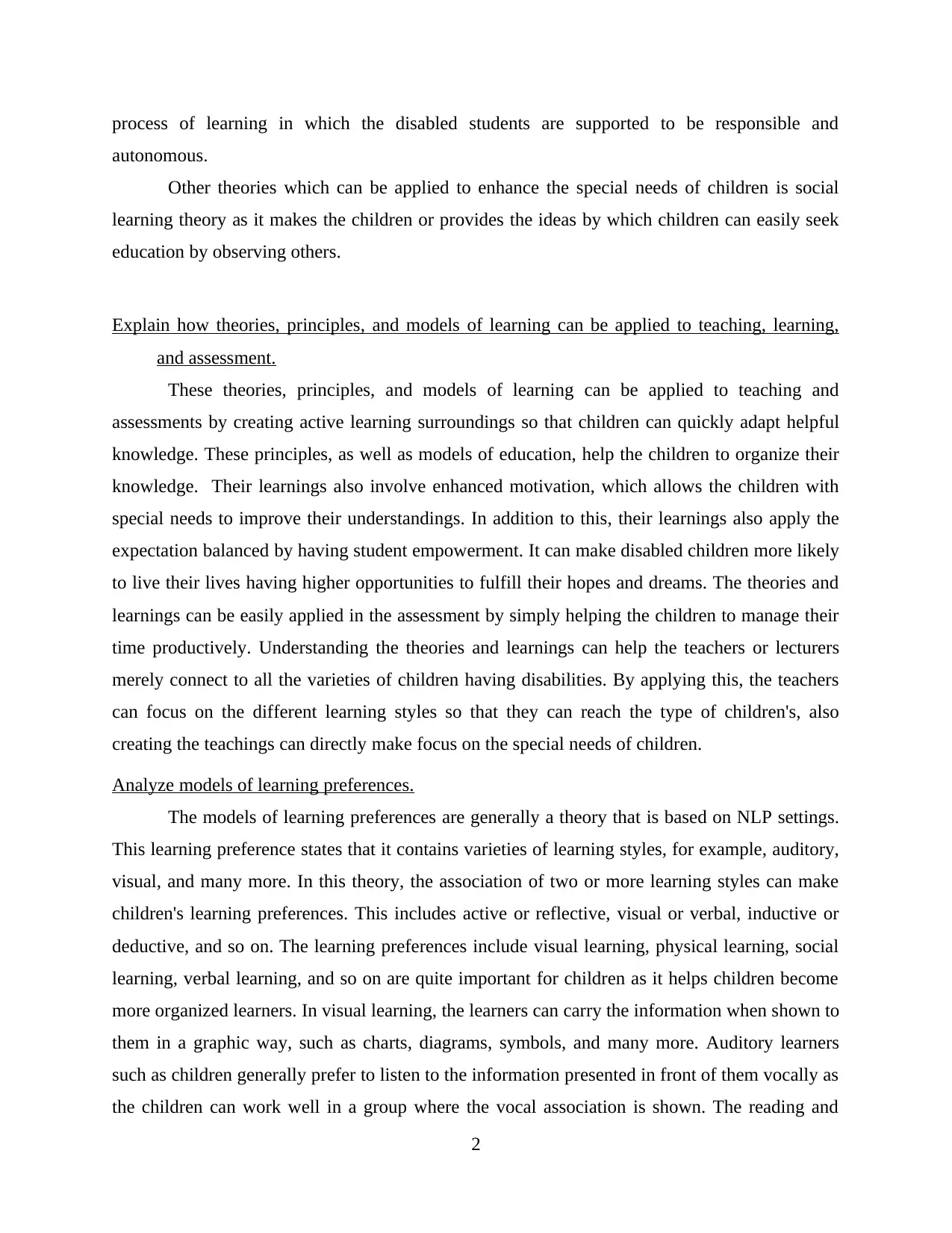
process of learning in which the disabled students are supported to be responsible and
autonomous.
Other theories which can be applied to enhance the special needs of children is social
learning theory as it makes the children or provides the ideas by which children can easily seek
education by observing others.
Explain how theories, principles, and models of learning can be applied to teaching, learning,
and assessment.
These theories, principles, and models of learning can be applied to teaching and
assessments by creating active learning surroundings so that children can quickly adapt helpful
knowledge. These principles, as well as models of education, help the children to organize their
knowledge. Their learnings also involve enhanced motivation, which allows the children with
special needs to improve their understandings. In addition to this, their learnings also apply the
expectation balanced by having student empowerment. It can make disabled children more likely
to live their lives having higher opportunities to fulfill their hopes and dreams. The theories and
learnings can be easily applied in the assessment by simply helping the children to manage their
time productively. Understanding the theories and learnings can help the teachers or lecturers
merely connect to all the varieties of children having disabilities. By applying this, the teachers
can focus on the different learning styles so that they can reach the type of children's, also
creating the teachings can directly make focus on the special needs of children.
Analyze models of learning preferences.
The models of learning preferences are generally a theory that is based on NLP settings.
This learning preference states that it contains varieties of learning styles, for example, auditory,
visual, and many more. In this theory, the association of two or more learning styles can make
children's learning preferences. This includes active or reflective, visual or verbal, inductive or
deductive, and so on. The learning preferences include visual learning, physical learning, social
learning, verbal learning, and so on are quite important for children as it helps children become
more organized learners. In visual learning, the learners can carry the information when shown to
them in a graphic way, such as charts, diagrams, symbols, and many more. Auditory learners
such as children generally prefer to listen to the information presented in front of them vocally as
the children can work well in a group where the vocal association is shown. The reading and
2
autonomous.
Other theories which can be applied to enhance the special needs of children is social
learning theory as it makes the children or provides the ideas by which children can easily seek
education by observing others.
Explain how theories, principles, and models of learning can be applied to teaching, learning,
and assessment.
These theories, principles, and models of learning can be applied to teaching and
assessments by creating active learning surroundings so that children can quickly adapt helpful
knowledge. These principles, as well as models of education, help the children to organize their
knowledge. Their learnings also involve enhanced motivation, which allows the children with
special needs to improve their understandings. In addition to this, their learnings also apply the
expectation balanced by having student empowerment. It can make disabled children more likely
to live their lives having higher opportunities to fulfill their hopes and dreams. The theories and
learnings can be easily applied in the assessment by simply helping the children to manage their
time productively. Understanding the theories and learnings can help the teachers or lecturers
merely connect to all the varieties of children having disabilities. By applying this, the teachers
can focus on the different learning styles so that they can reach the type of children's, also
creating the teachings can directly make focus on the special needs of children.
Analyze models of learning preferences.
The models of learning preferences are generally a theory that is based on NLP settings.
This learning preference states that it contains varieties of learning styles, for example, auditory,
visual, and many more. In this theory, the association of two or more learning styles can make
children's learning preferences. This includes active or reflective, visual or verbal, inductive or
deductive, and so on. The learning preferences include visual learning, physical learning, social
learning, verbal learning, and so on are quite important for children as it helps children become
more organized learners. In visual learning, the learners can carry the information when shown to
them in a graphic way, such as charts, diagrams, symbols, and many more. Auditory learners
such as children generally prefer to listen to the information presented in front of them vocally as
the children can work well in a group where the vocal association is shown. The reading and
2
Paraphrase This Document
Need a fresh take? Get an instant paraphrase of this document with our AI Paraphraser
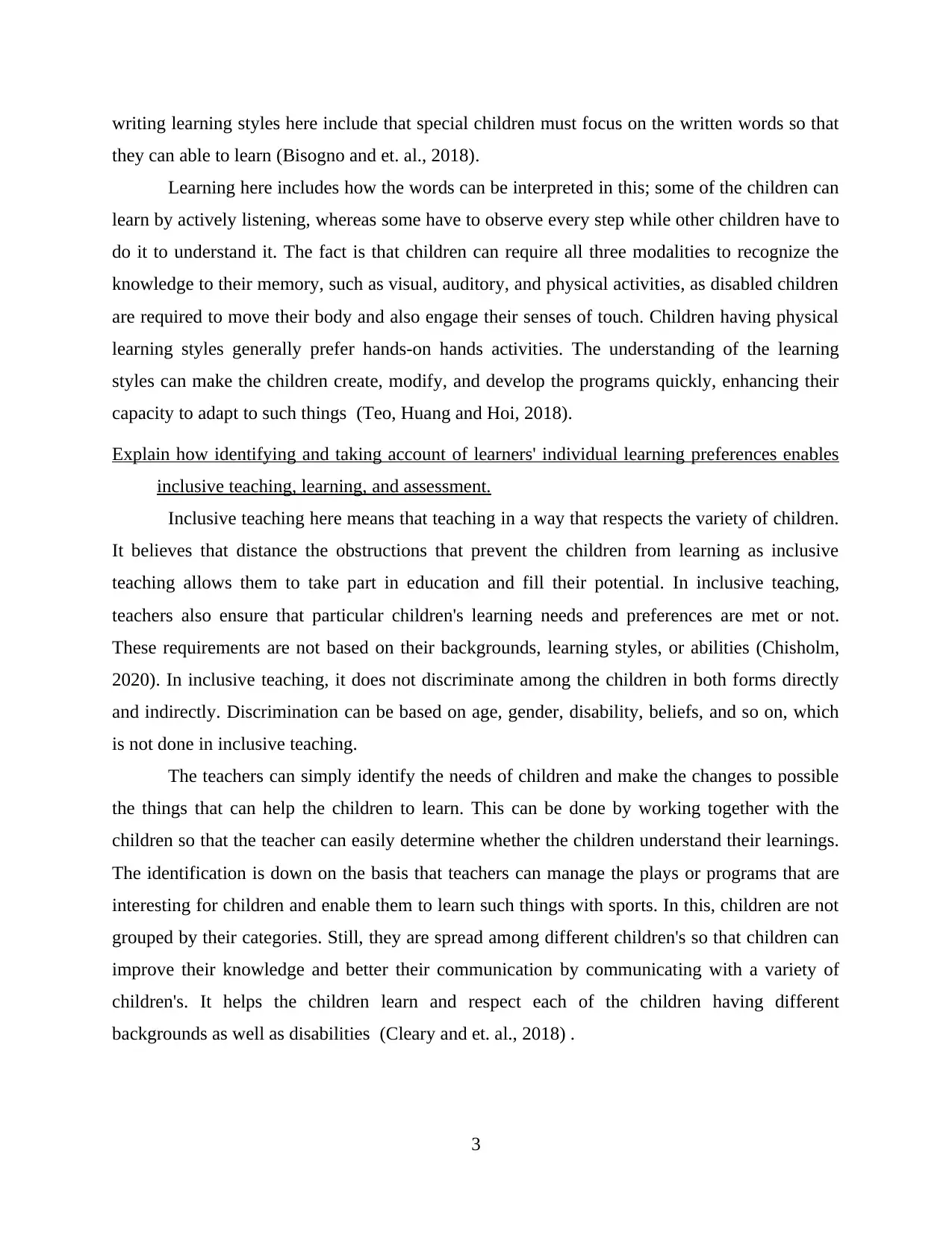
writing learning styles here include that special children must focus on the written words so that
they can able to learn (Bisogno and et. al., 2018).
Learning here includes how the words can be interpreted in this; some of the children can
learn by actively listening, whereas some have to observe every step while other children have to
do it to understand it. The fact is that children can require all three modalities to recognize the
knowledge to their memory, such as visual, auditory, and physical activities, as disabled children
are required to move their body and also engage their senses of touch. Children having physical
learning styles generally prefer hands-on hands activities. The understanding of the learning
styles can make the children create, modify, and develop the programs quickly, enhancing their
capacity to adapt to such things (Teo, Huang and Hoi, 2018).
Explain how identifying and taking account of learners' individual learning preferences enables
inclusive teaching, learning, and assessment.
Inclusive teaching here means that teaching in a way that respects the variety of children.
It believes that distance the obstructions that prevent the children from learning as inclusive
teaching allows them to take part in education and fill their potential. In inclusive teaching,
teachers also ensure that particular children's learning needs and preferences are met or not.
These requirements are not based on their backgrounds, learning styles, or abilities (Chisholm,
2020). In inclusive teaching, it does not discriminate among the children in both forms directly
and indirectly. Discrimination can be based on age, gender, disability, beliefs, and so on, which
is not done in inclusive teaching.
The teachers can simply identify the needs of children and make the changes to possible
the things that can help the children to learn. This can be done by working together with the
children so that the teacher can easily determine whether the children understand their learnings.
The identification is down on the basis that teachers can manage the plays or programs that are
interesting for children and enable them to learn such things with sports. In this, children are not
grouped by their categories. Still, they are spread among different children's so that children can
improve their knowledge and better their communication by communicating with a variety of
children's. It helps the children learn and respect each of the children having different
backgrounds as well as disabilities (Cleary and et. al., 2018) .
3
they can able to learn (Bisogno and et. al., 2018).
Learning here includes how the words can be interpreted in this; some of the children can
learn by actively listening, whereas some have to observe every step while other children have to
do it to understand it. The fact is that children can require all three modalities to recognize the
knowledge to their memory, such as visual, auditory, and physical activities, as disabled children
are required to move their body and also engage their senses of touch. Children having physical
learning styles generally prefer hands-on hands activities. The understanding of the learning
styles can make the children create, modify, and develop the programs quickly, enhancing their
capacity to adapt to such things (Teo, Huang and Hoi, 2018).
Explain how identifying and taking account of learners' individual learning preferences enables
inclusive teaching, learning, and assessment.
Inclusive teaching here means that teaching in a way that respects the variety of children.
It believes that distance the obstructions that prevent the children from learning as inclusive
teaching allows them to take part in education and fill their potential. In inclusive teaching,
teachers also ensure that particular children's learning needs and preferences are met or not.
These requirements are not based on their backgrounds, learning styles, or abilities (Chisholm,
2020). In inclusive teaching, it does not discriminate among the children in both forms directly
and indirectly. Discrimination can be based on age, gender, disability, beliefs, and so on, which
is not done in inclusive teaching.
The teachers can simply identify the needs of children and make the changes to possible
the things that can help the children to learn. This can be done by working together with the
children so that the teacher can easily determine whether the children understand their learnings.
The identification is down on the basis that teachers can manage the plays or programs that are
interesting for children and enable them to learn such things with sports. In this, children are not
grouped by their categories. Still, they are spread among different children's so that children can
improve their knowledge and better their communication by communicating with a variety of
children's. It helps the children learn and respect each of the children having different
backgrounds as well as disabilities (Cleary and et. al., 2018) .
3
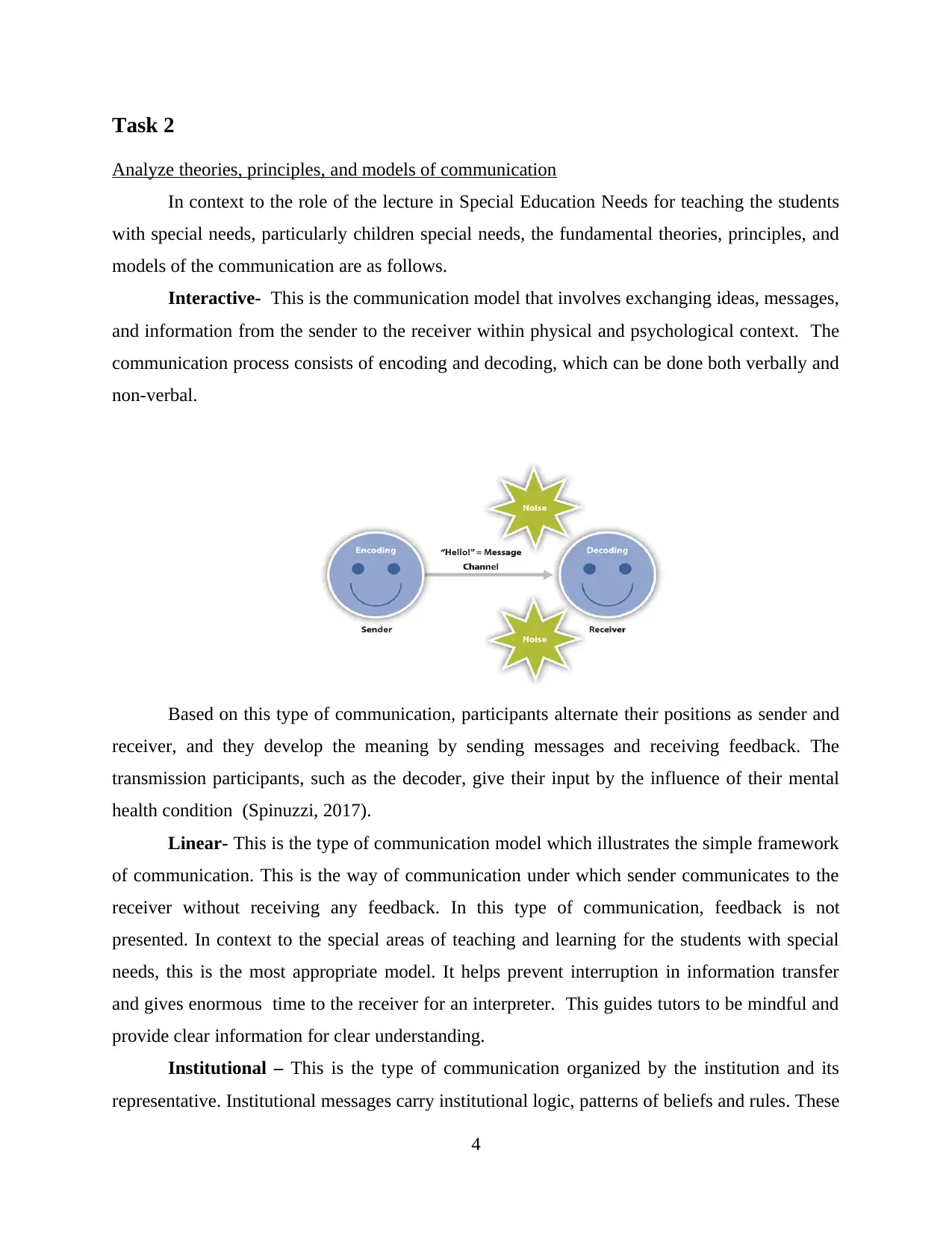
Task 2
Analyze theories, principles, and models of communication
In context to the role of the lecture in Special Education Needs for teaching the students
with special needs, particularly children special needs, the fundamental theories, principles, and
models of the communication are as follows.
Interactive- This is the communication model that involves exchanging ideas, messages,
and information from the sender to the receiver within physical and psychological context. The
communication process consists of encoding and decoding, which can be done both verbally and
non-verbal.
Based on this type of communication, participants alternate their positions as sender and
receiver, and they develop the meaning by sending messages and receiving feedback. The
transmission participants, such as the decoder, give their input by the influence of their mental
health condition (Spinuzzi, 2017).
Linear- This is the type of communication model which illustrates the simple framework
of communication. This is the way of communication under which sender communicates to the
receiver without receiving any feedback. In this type of communication, feedback is not
presented. In context to the special areas of teaching and learning for the students with special
needs, this is the most appropriate model. It helps prevent interruption in information transfer
and gives enormous time to the receiver for an interpreter. This guides tutors to be mindful and
provide clear information for clear understanding.
Institutional – This is the type of communication organized by the institution and its
representative. Institutional messages carry institutional logic, patterns of beliefs and rules. These
4
Analyze theories, principles, and models of communication
In context to the role of the lecture in Special Education Needs for teaching the students
with special needs, particularly children special needs, the fundamental theories, principles, and
models of the communication are as follows.
Interactive- This is the communication model that involves exchanging ideas, messages,
and information from the sender to the receiver within physical and psychological context. The
communication process consists of encoding and decoding, which can be done both verbally and
non-verbal.
Based on this type of communication, participants alternate their positions as sender and
receiver, and they develop the meaning by sending messages and receiving feedback. The
transmission participants, such as the decoder, give their input by the influence of their mental
health condition (Spinuzzi, 2017).
Linear- This is the type of communication model which illustrates the simple framework
of communication. This is the way of communication under which sender communicates to the
receiver without receiving any feedback. In this type of communication, feedback is not
presented. In context to the special areas of teaching and learning for the students with special
needs, this is the most appropriate model. It helps prevent interruption in information transfer
and gives enormous time to the receiver for an interpreter. This guides tutors to be mindful and
provide clear information for clear understanding.
Institutional – This is the type of communication organized by the institution and its
representative. Institutional messages carry institutional logic, patterns of beliefs and rules. These
4
⊘ This is a preview!⊘
Do you want full access?
Subscribe today to unlock all pages.

Trusted by 1+ million students worldwide
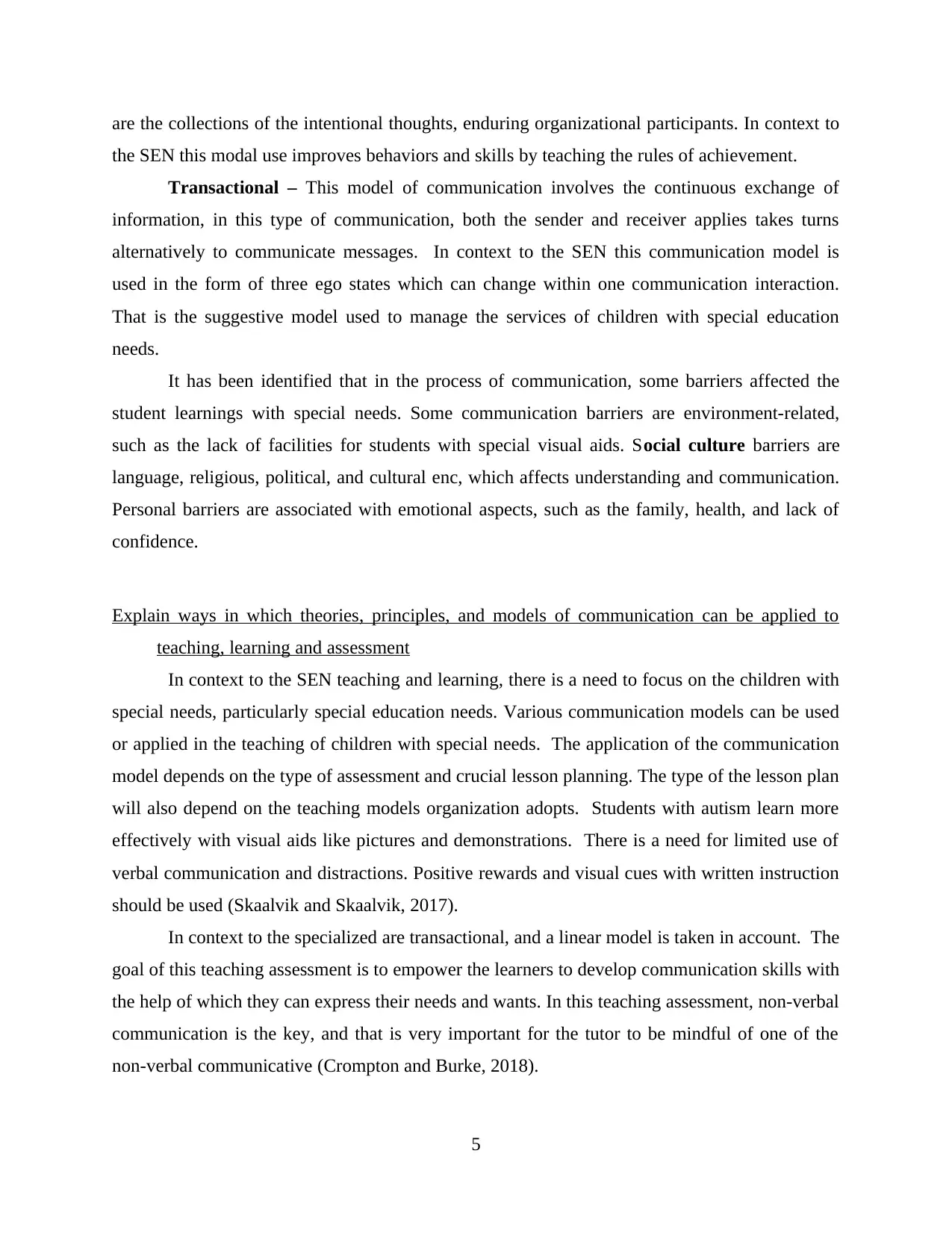
are the collections of the intentional thoughts, enduring organizational participants. In context to
the SEN this modal use improves behaviors and skills by teaching the rules of achievement.
Transactional – This model of communication involves the continuous exchange of
information, in this type of communication, both the sender and receiver applies takes turns
alternatively to communicate messages. In context to the SEN this communication model is
used in the form of three ego states which can change within one communication interaction.
That is the suggestive model used to manage the services of children with special education
needs.
It has been identified that in the process of communication, some barriers affected the
student learnings with special needs. Some communication barriers are environment-related,
such as the lack of facilities for students with special visual aids. Social culture barriers are
language, religious, political, and cultural enc, which affects understanding and communication.
Personal barriers are associated with emotional aspects, such as the family, health, and lack of
confidence.
Explain ways in which theories, principles, and models of communication can be applied to
teaching, learning and assessment
In context to the SEN teaching and learning, there is a need to focus on the children with
special needs, particularly special education needs. Various communication models can be used
or applied in the teaching of children with special needs. The application of the communication
model depends on the type of assessment and crucial lesson planning. The type of the lesson plan
will also depend on the teaching models organization adopts. Students with autism learn more
effectively with visual aids like pictures and demonstrations. There is a need for limited use of
verbal communication and distractions. Positive rewards and visual cues with written instruction
should be used (Skaalvik and Skaalvik, 2017).
In context to the specialized are transactional, and a linear model is taken in account. The
goal of this teaching assessment is to empower the learners to develop communication skills with
the help of which they can express their needs and wants. In this teaching assessment, non-verbal
communication is the key, and that is very important for the tutor to be mindful of one of the
non-verbal communicative (Crompton and Burke, 2018).
5
the SEN this modal use improves behaviors and skills by teaching the rules of achievement.
Transactional – This model of communication involves the continuous exchange of
information, in this type of communication, both the sender and receiver applies takes turns
alternatively to communicate messages. In context to the SEN this communication model is
used in the form of three ego states which can change within one communication interaction.
That is the suggestive model used to manage the services of children with special education
needs.
It has been identified that in the process of communication, some barriers affected the
student learnings with special needs. Some communication barriers are environment-related,
such as the lack of facilities for students with special visual aids. Social culture barriers are
language, religious, political, and cultural enc, which affects understanding and communication.
Personal barriers are associated with emotional aspects, such as the family, health, and lack of
confidence.
Explain ways in which theories, principles, and models of communication can be applied to
teaching, learning and assessment
In context to the SEN teaching and learning, there is a need to focus on the children with
special needs, particularly special education needs. Various communication models can be used
or applied in the teaching of children with special needs. The application of the communication
model depends on the type of assessment and crucial lesson planning. The type of the lesson plan
will also depend on the teaching models organization adopts. Students with autism learn more
effectively with visual aids like pictures and demonstrations. There is a need for limited use of
verbal communication and distractions. Positive rewards and visual cues with written instruction
should be used (Skaalvik and Skaalvik, 2017).
In context to the specialized are transactional, and a linear model is taken in account. The
goal of this teaching assessment is to empower the learners to develop communication skills with
the help of which they can express their needs and wants. In this teaching assessment, non-verbal
communication is the key, and that is very important for the tutor to be mindful of one of the
non-verbal communicative (Crompton and Burke, 2018).
5
Paraphrase This Document
Need a fresh take? Get an instant paraphrase of this document with our AI Paraphraser
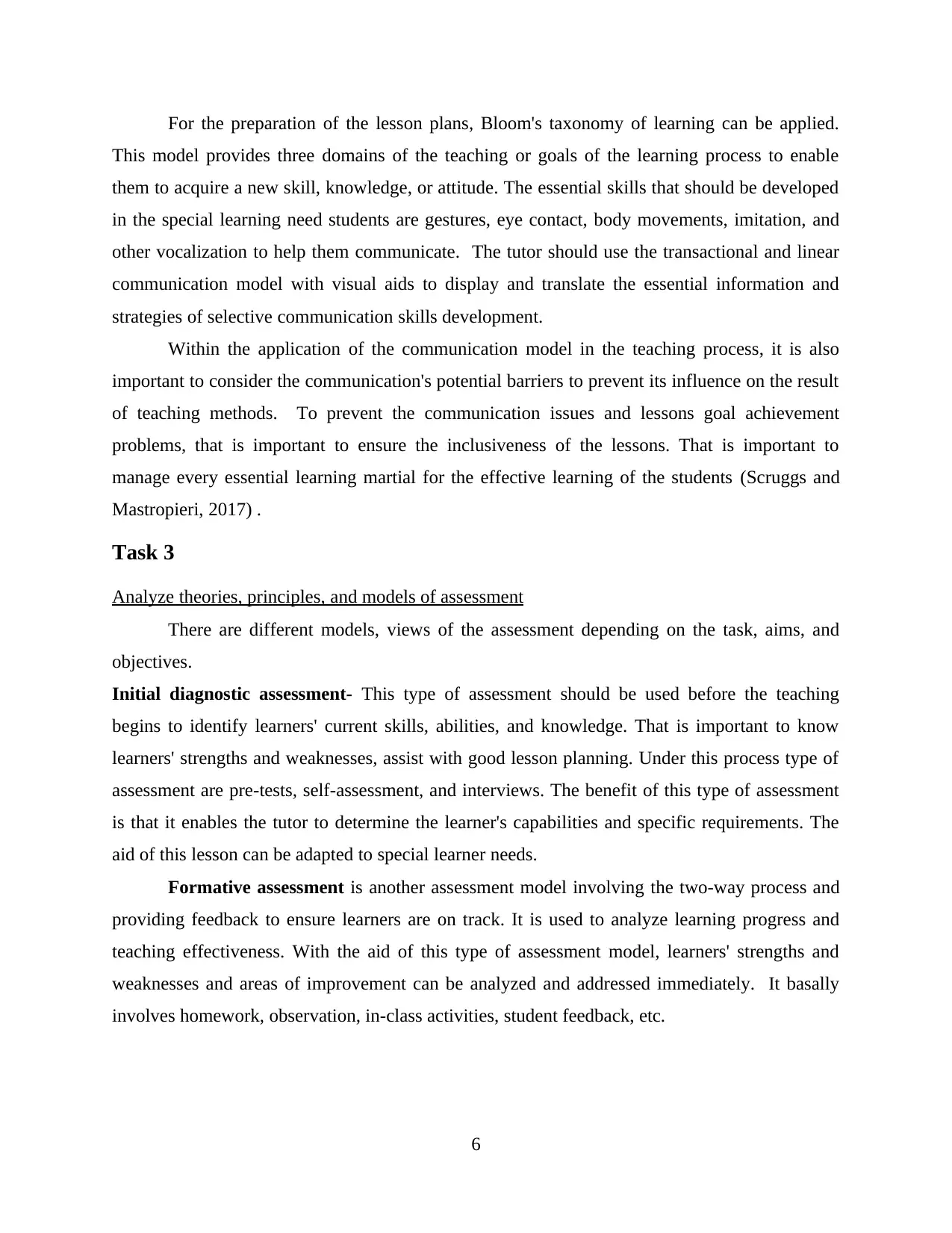
For the preparation of the lesson plans, Bloom's taxonomy of learning can be applied.
This model provides three domains of the teaching or goals of the learning process to enable
them to acquire a new skill, knowledge, or attitude. The essential skills that should be developed
in the special learning need students are gestures, eye contact, body movements, imitation, and
other vocalization to help them communicate. The tutor should use the transactional and linear
communication model with visual aids to display and translate the essential information and
strategies of selective communication skills development.
Within the application of the communication model in the teaching process, it is also
important to consider the communication's potential barriers to prevent its influence on the result
of teaching methods. To prevent the communication issues and lessons goal achievement
problems, that is important to ensure the inclusiveness of the lessons. That is important to
manage every essential learning martial for the effective learning of the students (Scruggs and
Mastropieri, 2017) .
Task 3
Analyze theories, principles, and models of assessment
There are different models, views of the assessment depending on the task, aims, and
objectives.
Initial diagnostic assessment- This type of assessment should be used before the teaching
begins to identify learners' current skills, abilities, and knowledge. That is important to know
learners' strengths and weaknesses, assist with good lesson planning. Under this process type of
assessment are pre-tests, self-assessment, and interviews. The benefit of this type of assessment
is that it enables the tutor to determine the learner's capabilities and specific requirements. The
aid of this lesson can be adapted to special learner needs.
Formative assessment is another assessment model involving the two-way process and
providing feedback to ensure learners are on track. It is used to analyze learning progress and
teaching effectiveness. With the aid of this type of assessment model, learners' strengths and
weaknesses and areas of improvement can be analyzed and addressed immediately. It basally
involves homework, observation, in-class activities, student feedback, etc.
6
This model provides three domains of the teaching or goals of the learning process to enable
them to acquire a new skill, knowledge, or attitude. The essential skills that should be developed
in the special learning need students are gestures, eye contact, body movements, imitation, and
other vocalization to help them communicate. The tutor should use the transactional and linear
communication model with visual aids to display and translate the essential information and
strategies of selective communication skills development.
Within the application of the communication model in the teaching process, it is also
important to consider the communication's potential barriers to prevent its influence on the result
of teaching methods. To prevent the communication issues and lessons goal achievement
problems, that is important to ensure the inclusiveness of the lessons. That is important to
manage every essential learning martial for the effective learning of the students (Scruggs and
Mastropieri, 2017) .
Task 3
Analyze theories, principles, and models of assessment
There are different models, views of the assessment depending on the task, aims, and
objectives.
Initial diagnostic assessment- This type of assessment should be used before the teaching
begins to identify learners' current skills, abilities, and knowledge. That is important to know
learners' strengths and weaknesses, assist with good lesson planning. Under this process type of
assessment are pre-tests, self-assessment, and interviews. The benefit of this type of assessment
is that it enables the tutor to determine the learner's capabilities and specific requirements. The
aid of this lesson can be adapted to special learner needs.
Formative assessment is another assessment model involving the two-way process and
providing feedback to ensure learners are on track. It is used to analyze learning progress and
teaching effectiveness. With the aid of this type of assessment model, learners' strengths and
weaknesses and areas of improvement can be analyzed and addressed immediately. It basally
involves homework, observation, in-class activities, student feedback, etc.
6
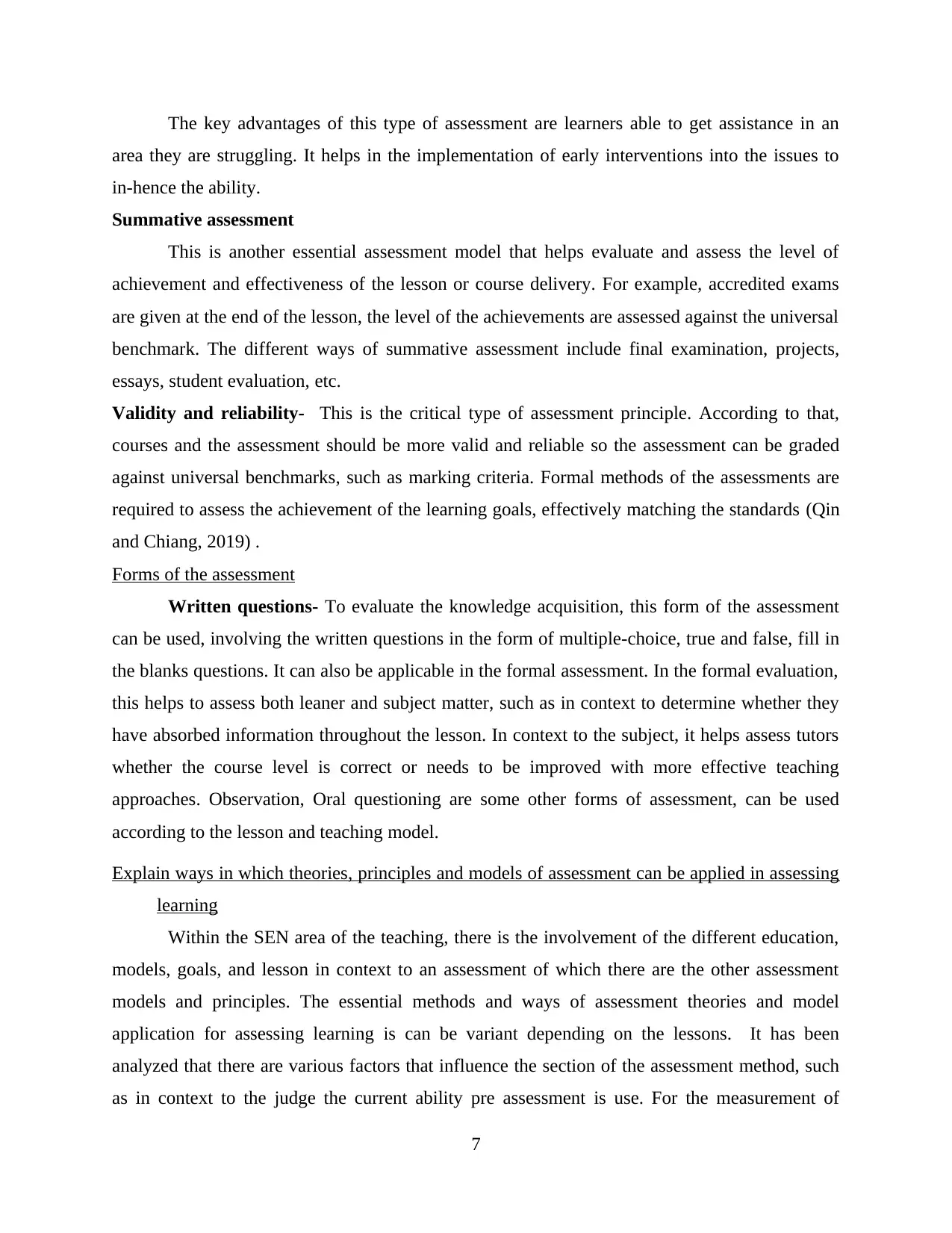
The key advantages of this type of assessment are learners able to get assistance in an
area they are struggling. It helps in the implementation of early interventions into the issues to
in-hence the ability.
Summative assessment
This is another essential assessment model that helps evaluate and assess the level of
achievement and effectiveness of the lesson or course delivery. For example, accredited exams
are given at the end of the lesson, the level of the achievements are assessed against the universal
benchmark. The different ways of summative assessment include final examination, projects,
essays, student evaluation, etc.
Validity and reliability- This is the critical type of assessment principle. According to that,
courses and the assessment should be more valid and reliable so the assessment can be graded
against universal benchmarks, such as marking criteria. Formal methods of the assessments are
required to assess the achievement of the learning goals, effectively matching the standards (Qin
and Chiang, 2019) .
Forms of the assessment
Written questions- To evaluate the knowledge acquisition, this form of the assessment
can be used, involving the written questions in the form of multiple-choice, true and false, fill in
the blanks questions. It can also be applicable in the formal assessment. In the formal evaluation,
this helps to assess both leaner and subject matter, such as in context to determine whether they
have absorbed information throughout the lesson. In context to the subject, it helps assess tutors
whether the course level is correct or needs to be improved with more effective teaching
approaches. Observation, Oral questioning are some other forms of assessment, can be used
according to the lesson and teaching model.
Explain ways in which theories, principles and models of assessment can be applied in assessing
learning
Within the SEN area of the teaching, there is the involvement of the different education,
models, goals, and lesson in context to an assessment of which there are the other assessment
models and principles. The essential methods and ways of assessment theories and model
application for assessing learning is can be variant depending on the lessons. It has been
analyzed that there are various factors that influence the section of the assessment method, such
as in context to the judge the current ability pre assessment is use. For the measurement of
7
area they are struggling. It helps in the implementation of early interventions into the issues to
in-hence the ability.
Summative assessment
This is another essential assessment model that helps evaluate and assess the level of
achievement and effectiveness of the lesson or course delivery. For example, accredited exams
are given at the end of the lesson, the level of the achievements are assessed against the universal
benchmark. The different ways of summative assessment include final examination, projects,
essays, student evaluation, etc.
Validity and reliability- This is the critical type of assessment principle. According to that,
courses and the assessment should be more valid and reliable so the assessment can be graded
against universal benchmarks, such as marking criteria. Formal methods of the assessments are
required to assess the achievement of the learning goals, effectively matching the standards (Qin
and Chiang, 2019) .
Forms of the assessment
Written questions- To evaluate the knowledge acquisition, this form of the assessment
can be used, involving the written questions in the form of multiple-choice, true and false, fill in
the blanks questions. It can also be applicable in the formal assessment. In the formal evaluation,
this helps to assess both leaner and subject matter, such as in context to determine whether they
have absorbed information throughout the lesson. In context to the subject, it helps assess tutors
whether the course level is correct or needs to be improved with more effective teaching
approaches. Observation, Oral questioning are some other forms of assessment, can be used
according to the lesson and teaching model.
Explain ways in which theories, principles and models of assessment can be applied in assessing
learning
Within the SEN area of the teaching, there is the involvement of the different education,
models, goals, and lesson in context to an assessment of which there are the other assessment
models and principles. The essential methods and ways of assessment theories and model
application for assessing learning is can be variant depending on the lessons. It has been
analyzed that there are various factors that influence the section of the assessment method, such
as in context to the judge the current ability pre assessment is use. For the measurement of
7
⊘ This is a preview!⊘
Do you want full access?
Subscribe today to unlock all pages.

Trusted by 1+ million students worldwide
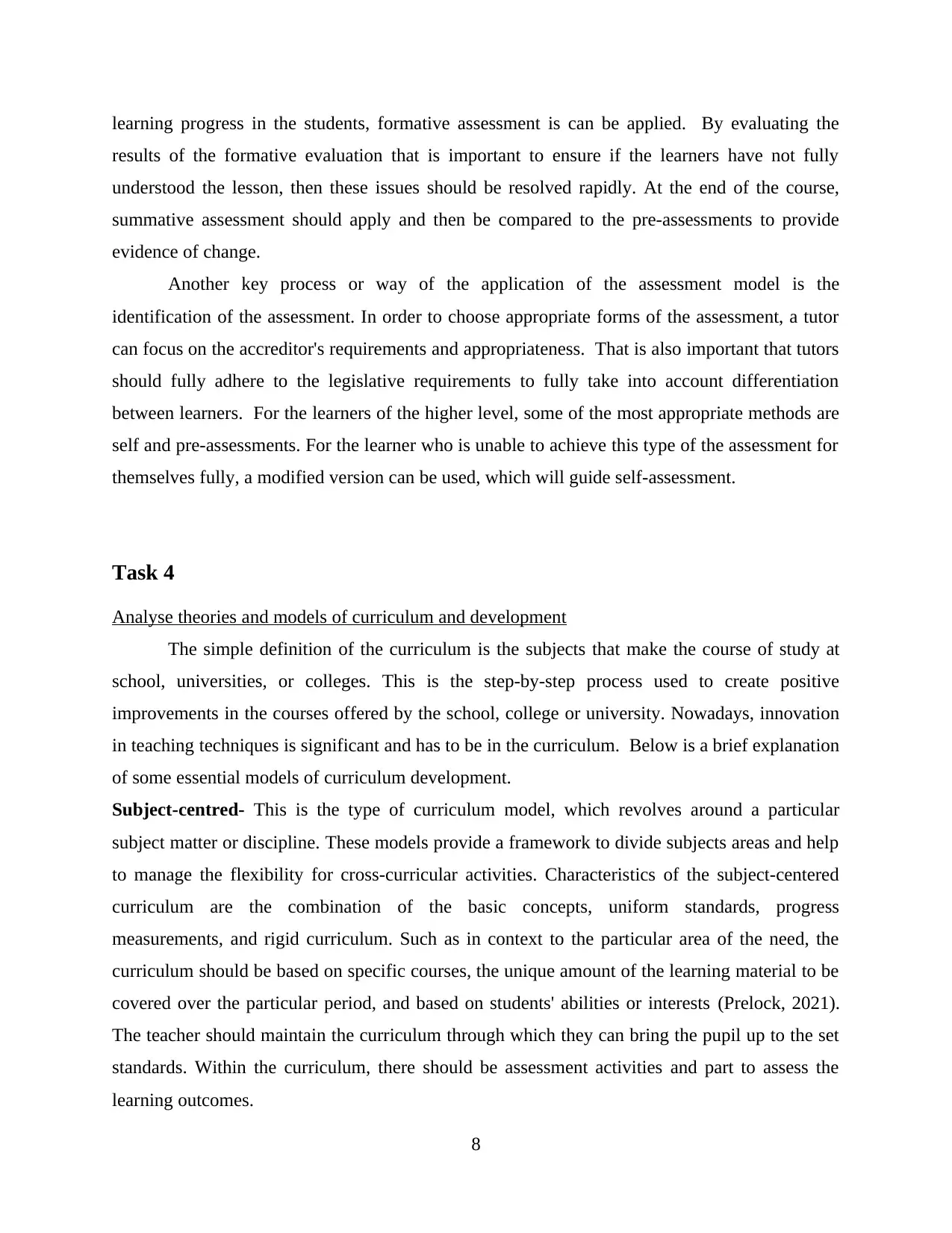
learning progress in the students, formative assessment is can be applied. By evaluating the
results of the formative evaluation that is important to ensure if the learners have not fully
understood the lesson, then these issues should be resolved rapidly. At the end of the course,
summative assessment should apply and then be compared to the pre-assessments to provide
evidence of change.
Another key process or way of the application of the assessment model is the
identification of the assessment. In order to choose appropriate forms of the assessment, a tutor
can focus on the accreditor's requirements and appropriateness. That is also important that tutors
should fully adhere to the legislative requirements to fully take into account differentiation
between learners. For the learners of the higher level, some of the most appropriate methods are
self and pre-assessments. For the learner who is unable to achieve this type of the assessment for
themselves fully, a modified version can be used, which will guide self-assessment.
Task 4
Analyse theories and models of curriculum and development
The simple definition of the curriculum is the subjects that make the course of study at
school, universities, or colleges. This is the step-by-step process used to create positive
improvements in the courses offered by the school, college or university. Nowadays, innovation
in teaching techniques is significant and has to be in the curriculum. Below is a brief explanation
of some essential models of curriculum development.
Subject-centred- This is the type of curriculum model, which revolves around a particular
subject matter or discipline. These models provide a framework to divide subjects areas and help
to manage the flexibility for cross-curricular activities. Characteristics of the subject-centered
curriculum are the combination of the basic concepts, uniform standards, progress
measurements, and rigid curriculum. Such as in context to the particular area of the need, the
curriculum should be based on specific courses, the unique amount of the learning material to be
covered over the particular period, and based on students' abilities or interests (Prelock, 2021).
The teacher should maintain the curriculum through which they can bring the pupil up to the set
standards. Within the curriculum, there should be assessment activities and part to assess the
learning outcomes.
8
results of the formative evaluation that is important to ensure if the learners have not fully
understood the lesson, then these issues should be resolved rapidly. At the end of the course,
summative assessment should apply and then be compared to the pre-assessments to provide
evidence of change.
Another key process or way of the application of the assessment model is the
identification of the assessment. In order to choose appropriate forms of the assessment, a tutor
can focus on the accreditor's requirements and appropriateness. That is also important that tutors
should fully adhere to the legislative requirements to fully take into account differentiation
between learners. For the learners of the higher level, some of the most appropriate methods are
self and pre-assessments. For the learner who is unable to achieve this type of the assessment for
themselves fully, a modified version can be used, which will guide self-assessment.
Task 4
Analyse theories and models of curriculum and development
The simple definition of the curriculum is the subjects that make the course of study at
school, universities, or colleges. This is the step-by-step process used to create positive
improvements in the courses offered by the school, college or university. Nowadays, innovation
in teaching techniques is significant and has to be in the curriculum. Below is a brief explanation
of some essential models of curriculum development.
Subject-centred- This is the type of curriculum model, which revolves around a particular
subject matter or discipline. These models provide a framework to divide subjects areas and help
to manage the flexibility for cross-curricular activities. Characteristics of the subject-centered
curriculum are the combination of the basic concepts, uniform standards, progress
measurements, and rigid curriculum. Such as in context to the particular area of the need, the
curriculum should be based on specific courses, the unique amount of the learning material to be
covered over the particular period, and based on students' abilities or interests (Prelock, 2021).
The teacher should maintain the curriculum through which they can bring the pupil up to the set
standards. Within the curriculum, there should be assessment activities and part to assess the
learning outcomes.
8
Paraphrase This Document
Need a fresh take? Get an instant paraphrase of this document with our AI Paraphraser
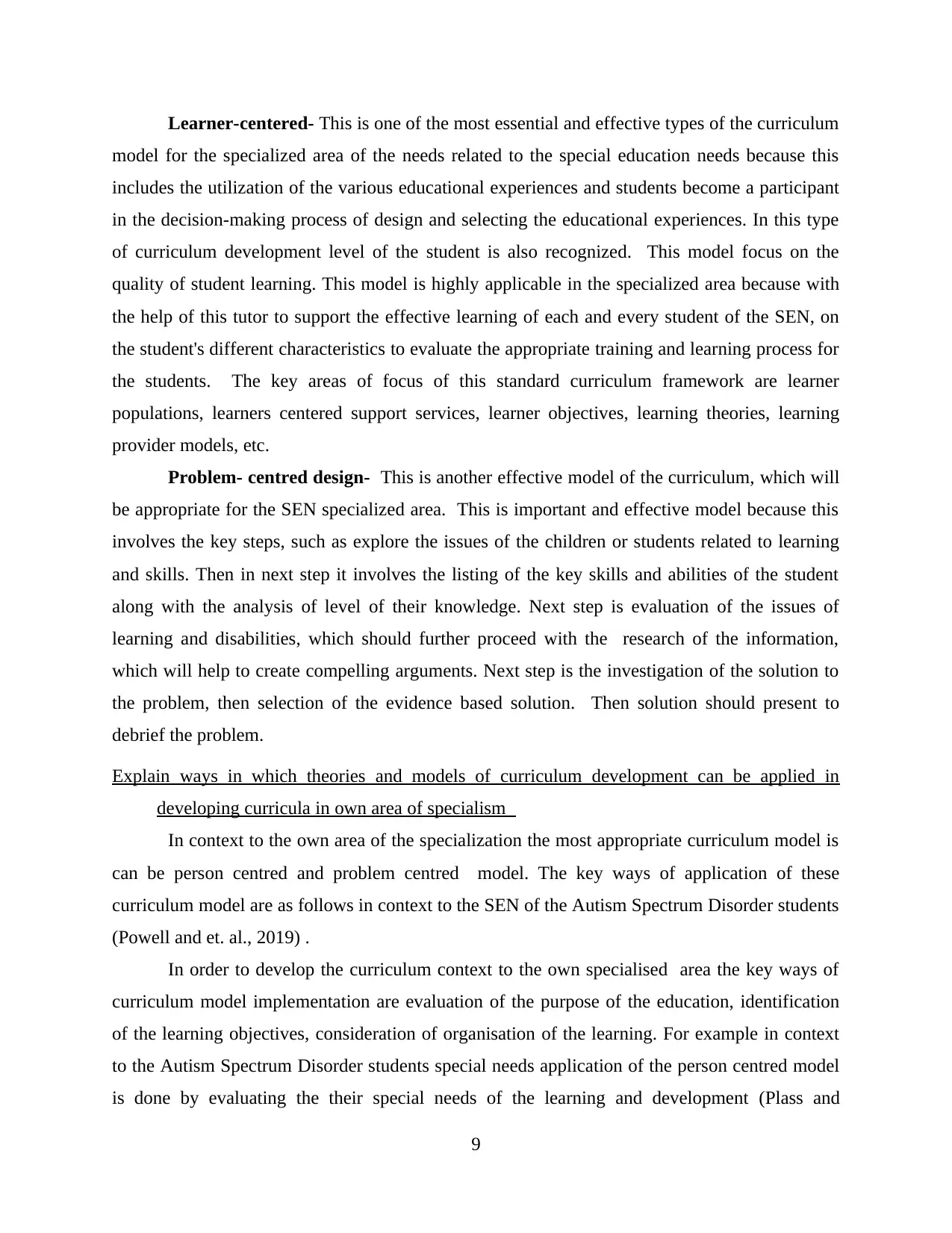
Learner-centered- This is one of the most essential and effective types of the curriculum
model for the specialized area of the needs related to the special education needs because this
includes the utilization of the various educational experiences and students become a participant
in the decision-making process of design and selecting the educational experiences. In this type
of curriculum development level of the student is also recognized. This model focus on the
quality of student learning. This model is highly applicable in the specialized area because with
the help of this tutor to support the effective learning of each and every student of the SEN, on
the student's different characteristics to evaluate the appropriate training and learning process for
the students. The key areas of focus of this standard curriculum framework are learner
populations, learners centered support services, learner objectives, learning theories, learning
provider models, etc.
Problem- centred design- This is another effective model of the curriculum, which will
be appropriate for the SEN specialized area. This is important and effective model because this
involves the key steps, such as explore the issues of the children or students related to learning
and skills. Then in next step it involves the listing of the key skills and abilities of the student
along with the analysis of level of their knowledge. Next step is evaluation of the issues of
learning and disabilities, which should further proceed with the research of the information,
which will help to create compelling arguments. Next step is the investigation of the solution to
the problem, then selection of the evidence based solution. Then solution should present to
debrief the problem.
Explain ways in which theories and models of curriculum development can be applied in
developing curricula in own area of specialism
In context to the own area of the specialization the most appropriate curriculum model is
can be person centred and problem centred model. The key ways of application of these
curriculum model are as follows in context to the SEN of the Autism Spectrum Disorder students
(Powell and et. al., 2019) .
In order to develop the curriculum context to the own specialised area the key ways of
curriculum model implementation are evaluation of the purpose of the education, identification
of the learning objectives, consideration of organisation of the learning. For example in context
to the Autism Spectrum Disorder students special needs application of the person centred model
is done by evaluating the their special needs of the learning and development (Plass and
9
model for the specialized area of the needs related to the special education needs because this
includes the utilization of the various educational experiences and students become a participant
in the decision-making process of design and selecting the educational experiences. In this type
of curriculum development level of the student is also recognized. This model focus on the
quality of student learning. This model is highly applicable in the specialized area because with
the help of this tutor to support the effective learning of each and every student of the SEN, on
the student's different characteristics to evaluate the appropriate training and learning process for
the students. The key areas of focus of this standard curriculum framework are learner
populations, learners centered support services, learner objectives, learning theories, learning
provider models, etc.
Problem- centred design- This is another effective model of the curriculum, which will
be appropriate for the SEN specialized area. This is important and effective model because this
involves the key steps, such as explore the issues of the children or students related to learning
and skills. Then in next step it involves the listing of the key skills and abilities of the student
along with the analysis of level of their knowledge. Next step is evaluation of the issues of
learning and disabilities, which should further proceed with the research of the information,
which will help to create compelling arguments. Next step is the investigation of the solution to
the problem, then selection of the evidence based solution. Then solution should present to
debrief the problem.
Explain ways in which theories and models of curriculum development can be applied in
developing curricula in own area of specialism
In context to the own area of the specialization the most appropriate curriculum model is
can be person centred and problem centred model. The key ways of application of these
curriculum model are as follows in context to the SEN of the Autism Spectrum Disorder students
(Powell and et. al., 2019) .
In order to develop the curriculum context to the own specialised area the key ways of
curriculum model implementation are evaluation of the purpose of the education, identification
of the learning objectives, consideration of organisation of the learning. For example in context
to the Autism Spectrum Disorder students special needs application of the person centred model
is done by evaluating the their special needs of the learning and development (Plass and
9
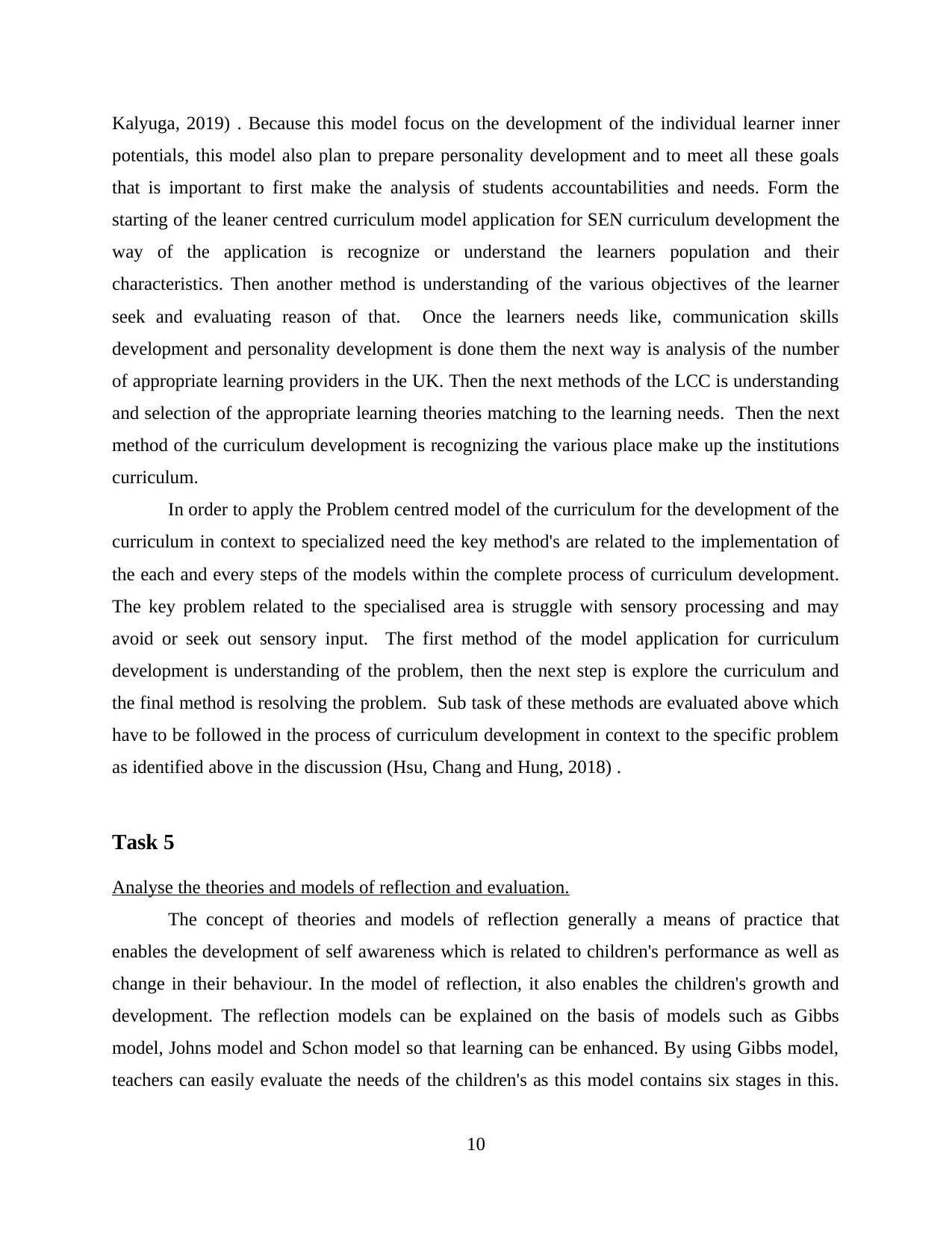
Kalyuga, 2019) . Because this model focus on the development of the individual learner inner
potentials, this model also plan to prepare personality development and to meet all these goals
that is important to first make the analysis of students accountabilities and needs. Form the
starting of the leaner centred curriculum model application for SEN curriculum development the
way of the application is recognize or understand the learners population and their
characteristics. Then another method is understanding of the various objectives of the learner
seek and evaluating reason of that. Once the learners needs like, communication skills
development and personality development is done them the next way is analysis of the number
of appropriate learning providers in the UK. Then the next methods of the LCC is understanding
and selection of the appropriate learning theories matching to the learning needs. Then the next
method of the curriculum development is recognizing the various place make up the institutions
curriculum.
In order to apply the Problem centred model of the curriculum for the development of the
curriculum in context to specialized need the key method's are related to the implementation of
the each and every steps of the models within the complete process of curriculum development.
The key problem related to the specialised area is struggle with sensory processing and may
avoid or seek out sensory input. The first method of the model application for curriculum
development is understanding of the problem, then the next step is explore the curriculum and
the final method is resolving the problem. Sub task of these methods are evaluated above which
have to be followed in the process of curriculum development in context to the specific problem
as identified above in the discussion (Hsu, Chang and Hung, 2018) .
Task 5
Analyse the theories and models of reflection and evaluation.
The concept of theories and models of reflection generally a means of practice that
enables the development of self awareness which is related to children's performance as well as
change in their behaviour. In the model of reflection, it also enables the children's growth and
development. The reflection models can be explained on the basis of models such as Gibbs
model, Johns model and Schon model so that learning can be enhanced. By using Gibbs model,
teachers can easily evaluate the needs of the children's as this model contains six stages in this.
10
potentials, this model also plan to prepare personality development and to meet all these goals
that is important to first make the analysis of students accountabilities and needs. Form the
starting of the leaner centred curriculum model application for SEN curriculum development the
way of the application is recognize or understand the learners population and their
characteristics. Then another method is understanding of the various objectives of the learner
seek and evaluating reason of that. Once the learners needs like, communication skills
development and personality development is done them the next way is analysis of the number
of appropriate learning providers in the UK. Then the next methods of the LCC is understanding
and selection of the appropriate learning theories matching to the learning needs. Then the next
method of the curriculum development is recognizing the various place make up the institutions
curriculum.
In order to apply the Problem centred model of the curriculum for the development of the
curriculum in context to specialized need the key method's are related to the implementation of
the each and every steps of the models within the complete process of curriculum development.
The key problem related to the specialised area is struggle with sensory processing and may
avoid or seek out sensory input. The first method of the model application for curriculum
development is understanding of the problem, then the next step is explore the curriculum and
the final method is resolving the problem. Sub task of these methods are evaluated above which
have to be followed in the process of curriculum development in context to the specific problem
as identified above in the discussion (Hsu, Chang and Hung, 2018) .
Task 5
Analyse the theories and models of reflection and evaluation.
The concept of theories and models of reflection generally a means of practice that
enables the development of self awareness which is related to children's performance as well as
change in their behaviour. In the model of reflection, it also enables the children's growth and
development. The reflection models can be explained on the basis of models such as Gibbs
model, Johns model and Schon model so that learning can be enhanced. By using Gibbs model,
teachers can easily evaluate the needs of the children's as this model contains six stages in this.
10
⊘ This is a preview!⊘
Do you want full access?
Subscribe today to unlock all pages.

Trusted by 1+ million students worldwide
1 out of 18
Related Documents
Your All-in-One AI-Powered Toolkit for Academic Success.
+13062052269
info@desklib.com
Available 24*7 on WhatsApp / Email
![[object Object]](/_next/static/media/star-bottom.7253800d.svg)
Unlock your academic potential
Copyright © 2020–2025 A2Z Services. All Rights Reserved. Developed and managed by ZUCOL.
